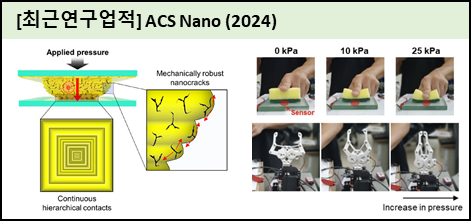|
Title |
Mechanically Robust and Linearly Sensitive Soft Piezoresistive Pressure Sensor for a Wearable Human–Robot Interaction System |
|
Author list |
Kim, Seong Won; Lee, Jeng-Hun; Ko, Hyeon Ju; Lee, Siyoung; Bae, Geun Yeol; Kim, Daegun; Lee, Giwon; Lee, Seung Goo; Cho, Kilwon |
|
Publication date |
2024/01/18 |
|
Citation information |
ACS Nano, 18, 3151-3160 (2024) |
|
Abbreviation of Journal Name |
ACS Nano |
|
DOI |
10.1021/acsnano.3c09016 |
|
Graphical Abstract |

|
|
Abstract |
Soft piezoresistive pressure sensors play an underpinning role in enabling a plethora of future Internet of Things (IoT) applications such as human–robot interaction (HRI) technologies, wearable devices, and metaverse ecosystems. Despite significant attempts to enhance the performance of these sensors, existing sensors still fall short of achieving high strain tolerance and linearity simultaneously. Herein, we present a low-cost, facile, and scalable approach to fabricating a highly strain-tolerant and linearly sensitive soft piezoresistive pressure sensor. Our design utilizes thin nanocracked gold films (NC-GFs) deposited on poly(dimethylsiloxane) (PDMS) as electrodes of the sensor. The large mismatch stress between gold (Au) and PDMS induces the formation of secondary wrinkles along the pyramidal-structured electrode under pressure; these wrinkles function as protuberances on the electrode and enable exceptional linear sensitivity of 4.2 kPa–1 over a wide pressure range. Additionally, our pressure sensor can maintain its performance even after severe mechanical deformations, including repeated stretching up to 30% strain, due to the outstanding strain tolerance of NC-GF. Our sensor’s impressive sensing performance and mechanical robustness make it suitable for diverse IoT applications, as demonstrated by its use in wearable pulse monitoring devices and human–robot interaction systems. |
|